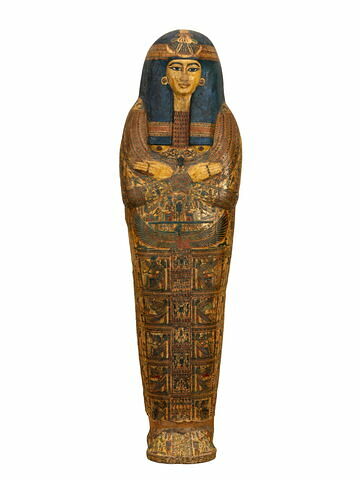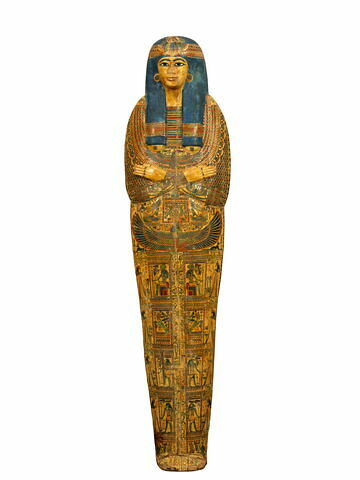Fullscreen Modal
Download
Next
Previous
Download image
Cercueil extérieur de Tanetnahereret
-1069 / -943 (XXIe dynastie)
Place of discovery : Thèbes Ouest
E 13027 ; BN 54 bis ? ; CM 12
Département des Antiquités égyptiennes
Currently on display at the Musée du Louvre
Salle 321
Aile Sully, Niveau 0
- Inventory number
-
Numéro principal : E 13027
Autre numéro d'inventaire : BN 54 bis ?
Numéro d'entrée : CM 12 - Collection
- Département des Antiquités égyptiennes
- Object name/Title
-
Dénomination : cercueil momiforme
Titre : Cercueil extérieur de Tanetnahereret - Description/Features
- femme (linceul, bras croisés, perruque tripartite, collier ousekh, boucles d'oreille, bandeau frontal, bague)
- Inscriptions
- Écriture :
hiéroglyphique
Nature du texte :
formules funéraires
nom
titre - Names and titles
- Tanetnahereret (maîtresse de maison, chanteuse-chémayt d'Amon, chanteuse-chémayt d'Amon-Rê roi des dieux, grande chanteuse-hésyt de Mout dame d'Ichérou, supérieure des nourrices)
- Dimensions
- Longueur : 215 cm ; Largeur : 71,5 cm ; Hauteur : 38 cm (Couvercle) ; Hauteur : 46 cm (cuve)
- Materials and techniques
-
Matériau : bois
Technique : peinture - Date
- XXIe dynastie (attribution d'après style) (-1069 - -943)
- Place of discovery
- Thèbes Ouest (Thèbes->région thébaine->Haute Égypte)
- Object history
- Seconde collection F. Cailliaud acquise en 1824 par le Cabinet des médailles de la Bibliothèque du Roi.
- Collector / Previous owner / Commissioner / Archaeologist / Dedicatee
-
Cailliaud de Nantes, Frédéric, Collectionneur, ?-1824
Cabinet des Médailles, Ancien affectataire
- Acquisition details
- affecté au Louvre
- Acquisition date
-
date de l'inscription sur l'inventaire : 1907
date de comité/commission : 28/11/1907 (Annonce de l'arrivée des objets transférés du Cabinet des Médailles au Louvre) - Owned by
- Etat
- Held by
- Musée du Louvre, Département des Antiquités égyptiennes
- Current location
-
Sully, [AE] Salle 321 - Les sarcophages, Vitrine 2
- Mode d'acquisition
- affecté au Louvre
- Name
- cercueil momiforme
- Materials
- bois
- Techniques
- peinture
- Description/Features
- bras croisés - femme - boucles d'oreille - bague - bandeau frontal - collier ousekh - linceul - perruque tripartite
- Names and titles
- maîtresse de maison - chanteuse-chémayt d'Amon - Tanetnahereret - chanteuse-chémayt d'Amon-Rê roi des dieux - grande chanteuse-hésyt de Mout dame d'Ichérou - supérieure des nourrices
- Period
- XXIe dynastie
- Places
- Thèbes Ouest
- Nature of text
- formules funéraires - nom - titre
- Script
- hiéroglyphique
-
Niwiński, Andrzej ; Rigault, Patricia, Les cercueils égyptiens de la XXIè au début de la XXIIe dynastie, [Musée du Louvre], Paris, Louvre éditions Editions Khéops, 2024, p. 6, 15, 26, 37, 39, 250-269, ill. p. 250-269, Cat.6 a-b
-
Mainieri, Stefania, « The “Invisible” Side of Yellow Coffin - The Set of the Chantress of Amun Tanethereret in the Musée du Louvre and Some Considerations on the Production of Yellow Coffins in the First Half of the 21st Dynasty », arts, 13, 2024, 24 p., Disponible sur : https://doi.org/10.3390/arts13060170 , passim, fig. 2, 4, 13
-
Rigault, Patricia, « Autour du cercueil de Ptahirdis. Les cercueils des personnages privés dans la première moitié du 1er millénaire avant J.-C. », Égypte, Afrique & Orient, 98, 2020, p. 21-32, p. 24, fig. 2
-
Cooney, Kathlyn Mary, « The end of the New Kingdom in Egypt. How ancient Egyptian funerary materials can help us understand society in crisis », dans Kubisch, Sabine ; Rummel, Ute (dir.), The Ramesside Period in Egypt. Studies into Cultural and Historical Processes of the 19th and 20th Dynasties. Proceedings of the International Symposium held in Heidelberg, 5th to 7th June 2015, Le Caire, De Gruyter, (Sonderschriften des Deutschen Archäologischen Instituts (SDAIK) ; 41), 2018, p. 63-88, p. 82, ill. p. 82
-
Aston, David A., « The "Third Cache" - Myth or Reality? », dans Jurman, Claus ; Bader, Bettina ; Aston, David A. (dir.), A True Scribe of Abydos. Essays on First Millennium Egypt in Honour of Anthony Leahy, Louvain / Paris / Bristol, Peeters, (Orientalia Lovaniensia Analecta (OLA) ; 265), 2017, p. 1-26, p. 4 note 16
-
Mainterot, Philippe, Aux origines de l'Égyptologie : voyages et collections de Frédéric Cailliaud (1787-1869), Rennes, Presses Universitaires de Rennes, (Collection "Art & Société"), 2011, p. 78, 140 note 58, 274
-
Mainterot, Philippe, « La redécouverte des collections de Frédéric Cailliaud : contribution à l’histoire de l’égyptologie », Histoire de l'art, 62, 2008, p. 43-54, p. 51, 54 note 30
-
Billing, Nils, Nut, The Goddess Of Life In Text And Iconography, Uppsala, Department of Archaeology and Ancient History, Uppsala University, (Uppsala studies in egyptology ; 5), 2002, p. 297
-
Aufrère, Sydney Hervé, « Les couleurs sacrées dans l'Égypte ancienne vibration d'une lumière minérale », Technè, la science au service de l'histoire de l'art et des civilisations, 9-10, Couleur et perception, 1999, p. 19-32, p. 27, Fig. 11 p. 27
-
Delange, Élisabeth ; Colinart, Sylvie, « Un champ d'observations : la restauration des sarcophages au Musée du Louvre », Bulletin de la Société française d'égyptologie (BSFE), 139, 1997, p. 21-22, fig. 3
-
Van Walsem, René, The coffin Of Djedmonthuiufankh in The national museum Of Antiquities at Leiden : Technical and iconographical, iconological aspects, II, Tables, Graphs etc, Illustations, Leiden, Nederlands Instituut voor Het Nabije Oosten, (Egyptologische uitgaven), 1997, p. 6
-
Chauvet, Michel, Frédéric Cailliaud. Les aventures d'un naturaliste en Égypte et au Soudan 1815-1822, Saint-Sébastien, Editions ACL-CROCUS, (Savants et hommes du 19e siècle), 1989, p. 38
-
Niwiński, Andrzej, The 21th Dynasty coffins From Thèbes: Chronongical and Typological Studies, Allemagne, Philipp von Zabern, 1988, p. 163-164, n° 328
-
Desroches-Noblecourt, Christiane (dir.), L'Égypte des pharaons, cat. exp. (Marcq-en-Baroeul, Fondation Anne et Albert Prouvost Septentrion, octobre 1977-janvier 1978), Marcq-en-Baroeul, Fondation Anne et Albert Prouvost Septentrion, 1977, p. 18, n° 33
-
Spiegelberg, Wilhelm, « Der ägyptische Possesivartikel », Zeitschrift für Ägyptische Sprache und Altertumskunde (ZÄS), 54, 1918, 7, p. 109
-
Ledrain, Eugène, Les monuments égyptiens de la Bibliothèque Nationale (Cabinet des Médailles et Antiques), Paris, F. Vieweg, 1879, pl. LXVIII, n° 54-55
-
- L'Égypte des pharaons, Marcq en Bareuil (Externe, France), Fondation Prouvost Septentrion, 01/10/1977 - 31/01/1978



